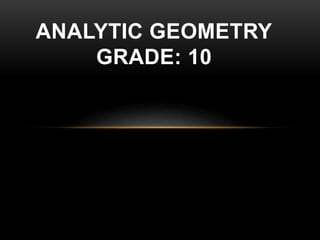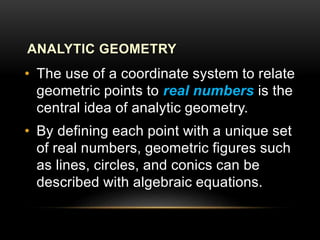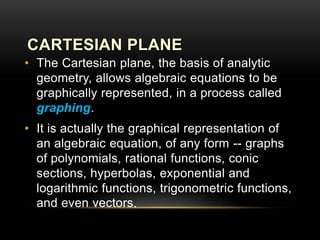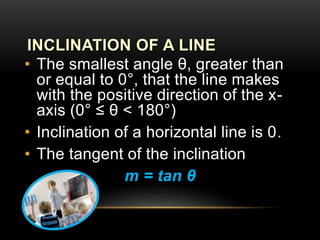Grade 10 analytical geometry
- 7. HISTORY Introduced in the 1630s , an important mathematical development, for it laid the foundations for modern mathematics as well as Aided the development of calculus RENE DESCARTES (1596-1650) and PIERRE DE FERMAT (1601-1665), French mathematicians, independently developed the foundations for analytical geometry
- 8. ANALYTIC GEOMETRY ŌĆó A branch of mathematics which uses algebraic equations to describe the size and position of geometric figures on a coordinate system.
- 9. ANALYTIC GEOMETRY ŌĆó The link between algebra and geometry was made possible by the development of a coordinate system which allowed geometric ideas, such as point and line, to be described in algebraic terms like real numbers and equations. ŌĆó Also known as Cartesian geometry or coordinate geometry.
- 10. ANALYTIC GEOMETRY ŌĆó The use of a coordinate system to relate geometric points to real numbers is the central idea of analytic geometry. ŌĆó By defining each point with a unique set of real numbers, geometric figures such as lines, circles, and conics can be described with algebraic equations.
- 11. CARTESIAN PLANE ŌĆó The Cartesian plane, the basis of analytic geometry, allows algebraic equations to be graphically represented, in a process called graphing. ŌĆó It is actually the graphical representation of an algebraic equation, of any form -- graphs of polynomials, rational functions, conic sections, hyperbolas, exponential and logarithmic functions, trigonometric functions, and even vectors.
- 12. CARTESIAN PLANE ŌĆó x-axis (horizontal axis) where the x values are plotted along. ŌĆó y-axis (vertical axis) where the y values are plotted along. ŌĆó origin, symbolized by 0, marks the value of 0 of both axes ŌĆó coordinates are given in the form (x,y) and is used to represent different points on the plane.
- 13. INCLINATION OF A LINE ŌĆó The smallest angle ╬Ė, greater than or equal to 0┬░, that the line makes with the positive direction of the x- axis (0┬░ Ōēż ╬Ė < 180┬░) ŌĆó Inclination of a horizontal line is 0. ŌĆó The tangent of the inclination m = tan ╬Ė
- 14. INCLINATION OF A LINE O M ╬Ė x y L O M ╬Ė x y L
- 15. ANGLE BETWEEN TWO LINES
- 16. ANGLE BETWEEN TWO LINES ŌĆó If ╬Ė is angle, measured counter clockwise, between two lines, then ŌĆó where m2 is the slope of the terminal side and m1 is the slope of the initial side
- 21. ŌŚÅA point is an ordered pair of numbers written as (x; y). ŌŚÅDistance is a measure of the length between two points. ŌŚÅThe formula for finding the distance between any two points is:
- 24. The formula for finding the mid-point between two points is:
- 26. SLOPE OF A LINE ŌĆó The slope or gradient of a line describes the steepness, incline or grade. ŌĆó A higher slope value indicates a steeper incline. ŌĆó Slope is normally described by the ratio of the ŌĆ£riseŌĆØ divided by the ŌĆ£runŌĆØ between two points on a line. ŌĆó The slope is denoted by ØÆÄ.
- 28. Gradient between two points ŌŚÅThe gradient between two points is determined by the ratio of vertical change to horizontal change. ŌŚÅThe formula for finding the gradient of a line is:
- 29. ŌĆó If line rises from left to right, ØÆÄ > ØÆÉ ŌĆó If line goes from right to left, ØÆÄ < Ø¤Ä ŌĆó If line is parallel to x-axis, ØÆÄ = Ø¤Ä ŌĆóIf line is parallel to y-axis, ØÆÄ = ØÆ¢ØÆÅØÆģØÆåØÆćØÆŖØÆÅØÆåØÆģ SLOPE OF A LINE
- 30. ŌĆó Two non-vertical lines are parallel if, and only if, their slopes are equal. ŌĆó Two slant lines are perpendicular if, and only if, the slope of one is the negative reciprocal of the slope of the other..(If two lines are perpendicular, the product of their gradients is equal to ŌłÆ1.) ŌĆó For horizontal lines the gradient is equal to 0. ŌĆó For vertical lines the gradient is undefined.
- 33. If 2 lines with gradients m1 and m2 are perpendicular then m1 ├Ś m2 = -1 Conversely: If m1 ├Ś m2 = -1 then the two lines with gradients m1 and m2 are perpendicular.
- 35. STRAIGHT LINE FACTS Y ŌĆō axis Intercept 2 1 2 1 y - y Gradient = x -x y = mx + c
- 36. Find the equation of the line which passes through the point (-1, 3) and is perpendicular to the line with equation 4 1 0x y’Ć½ ’ĆŁ ’ĆĮ
- 37. Find gradient of given line: 4 1 0 4 1 4x y y x m’Ć½ ’ĆŁ ’ĆĮ ’ā× ’ĆĮ ’ĆŁ ’Ć½ ’ā× ’ĆĮ ’ĆŁ Find gradient of perpendicular: 1 (using formula 1) 1 24 ’é┤ ’ĆĮ ’ĆŁ’ĆĮ m mm Find equation: 4 13 0y x’ĆŁ ’ĆŁ ’ĆĮ SOLUTION y ŌĆō b = m(x ŌĆō a) y ŌĆō 3 = ┬╝ (x ŌĆō(-1)) 4y ŌĆō 12 = x + 1
- 42. This presentation is a mash up of 6 different sources. These are: Felipe, N, M. (2014). Analytical geometry basic concepts [PowerPoint Presentation]. Available at: http://www.slideshare.net/NancyFelipe1/analytic- geometry-basic-concepts. Accessed on: 6 March 2014. Demirdag, D. (2013). Lecture #4 analytic geometry [PowerPoint Presentation]. Available at: http://www.slideshare.net/denmarmarasigan/lecture-4-analytic-geometry. Accessed on: 6 March 2014. Share, S. (2014). Analytical geometry [PowerPoint Presentation]. Available at: http://www.slideshare.net/SuziShare/analytical-geometry. Accessed on: 6 March 2014. Derirdag, D. (2012).Analytical geometry [PowerPoint Presentation]. Available at: http://www.slideshare.net/mstfdemirdag/analytic-geometry. Accessed on: 6 March 2014. Nolasco, C, M. Analytical geometry [PowerPoint Presentation]. Available at: http://www.slideshare.net/CecilleMaeNolasco/analytical-geometry. Accessed on: 6 March 2014. Siyavula_Education. (2012).Analytical geometry Everything Maths, Grade 10 [PowerPoint Presentation}. Available at: http://www.slideshare.net/Siyavula_Education/analytical- geometry?qid=9526d5d1-098f-45da-90b6- d503de7f2db5&v=default&b=&from_search=4). Accessed on: 6 March 2014.









































![This presentation is a mash up of 6 different sources. These are:
Felipe, N, M. (2014). Analytical geometry basic concepts [PowerPoint
Presentation]. Available at: http://www.slideshare.net/NancyFelipe1/analytic-
geometry-basic-concepts. Accessed on: 6 March 2014.
Demirdag, D. (2013). Lecture #4 analytic geometry [PowerPoint
Presentation]. Available at:
http://www.slideshare.net/denmarmarasigan/lecture-4-analytic-geometry.
Accessed on: 6 March 2014.
Share, S. (2014). Analytical geometry [PowerPoint Presentation]. Available
at: http://www.slideshare.net/SuziShare/analytical-geometry. Accessed on: 6
March 2014.
Derirdag, D. (2012).Analytical geometry [PowerPoint Presentation]. Available
at: http://www.slideshare.net/mstfdemirdag/analytic-geometry. Accessed on:
6 March 2014.
Nolasco, C, M. Analytical geometry [PowerPoint Presentation]. Available at:
http://www.slideshare.net/CecilleMaeNolasco/analytical-geometry. Accessed
on: 6 March 2014.
Siyavula_Education. (2012).Analytical geometry Everything Maths, Grade
10 [PowerPoint Presentation}. Available at:
http://www.slideshare.net/Siyavula_Education/analytical-
geometry?qid=9526d5d1-098f-45da-90b6-
d503de7f2db5&v=default&b=&from_search=4). Accessed on: 6 March 2014.](https://image.slidesharecdn.com/grade10analyticalgeometry-170824055354/85/Grade-10-analytical-geometry-42-320.jpg)